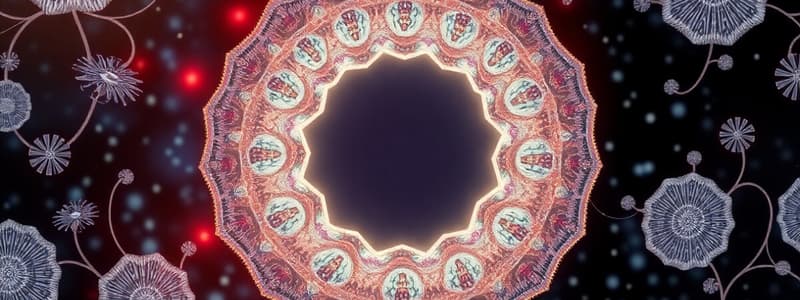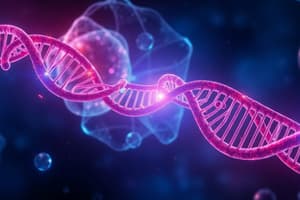Podcast
Questions and Answers
If a cell with a mutation is detected at the G1-S checkpoint, what is the immediate cellular response?
If a cell with a mutation is detected at the G1-S checkpoint, what is the immediate cellular response?
- Entry into the G0 phase for permanent cell cycle arrest.
- Immediate progression to the S phase for DNA replication.
- Activation of genes that inhibit the cell cycle.
- The cell cycle halts, and attempts are made to correct the mutation. (correct)
Which of the following cell types is LEAST likely to re-enter the cell cycle from the G0 phase?
Which of the following cell types is LEAST likely to re-enter the cell cycle from the G0 phase?
- Neurons (correct)
- Hepatocytes
- Skin cells
- Kidney tubule cells
During which phase of mitosis do the chromosomes align along the metaphase plate?
During which phase of mitosis do the chromosomes align along the metaphase plate?
- Anaphase
- Telophase
- Prophase
- Metaphase (correct)
What is the primary role of cyclin-dependent kinases (CDKs) in the cell cycle?
What is the primary role of cyclin-dependent kinases (CDKs) in the cell cycle?
What is the consequence of phosphorylating lamins during prophase?
What is the consequence of phosphorylating lamins during prophase?
What is the state of the DNA content in a cell during the G2 phase, compared to a cell in the G1 phase?
What is the state of the DNA content in a cell during the G2 phase, compared to a cell in the G1 phase?
A researcher introduces a drug that inhibits cytokinesis in a cell culture. What direct effect would this drug have on cell division?
A researcher introduces a drug that inhibits cytokinesis in a cell culture. What direct effect would this drug have on cell division?
Which of the following is the correct sequence of events in the cell cycle?
Which of the following is the correct sequence of events in the cell cycle?
If the 'blue' genes are activated, what effect will this have on the cell cycle progression, based on the information provided?
If the 'blue' genes are activated, what effect will this have on the cell cycle progression, based on the information provided?
During anaphase, what is the primary event that leads to the separation of chromosomes?
During anaphase, what is the primary event that leads to the separation of chromosomes?
What is the role of the signal transducer (produced from the responder gene) in the cell cycle control mechanism described?
What is the role of the signal transducer (produced from the responder gene) in the cell cycle control mechanism described?
Which of the following best describes the state of a cell during interphase?
Which of the following best describes the state of a cell during interphase?
A cell is treated with a drug that prevents the assembly of microtubules. Which stage of mitosis would be most directly affected?
A cell is treated with a drug that prevents the assembly of microtubules. Which stage of mitosis would be most directly affected?
How does the activation of cyclin-dependent kinases (CDKs) directly contribute to the progression of the cell cycle?
How does the activation of cyclin-dependent kinases (CDKs) directly contribute to the progression of the cell cycle?
What event characterizes the transition from metaphase to anaphase?
What event characterizes the transition from metaphase to anaphase?
Flashcards
Cell Cycle
Cell Cycle
The series of events a cell undergoes to divide into two daughter cells.
S Phase
S Phase
The phase of the cell cycle where DNA replication occurs, doubling the chromosome number from 2n to 4n.
G1 Phase
G1 Phase
Also known as growth phase 1, the cell prepares for DNA replication.
G2 Phase
G2 Phase
Signup and view all the flashcards
M Phase (Mitosis)
M Phase (Mitosis)
Signup and view all the flashcards
G0 Phase
G0 Phase
Signup and view all the flashcards
Labile Cells
Labile Cells
Signup and view all the flashcards
Stable Cells
Stable Cells
Signup and view all the flashcards
Permanent Cells
Permanent Cells
Signup and view all the flashcards
Mitosis
Mitosis
Signup and view all the flashcards
Interphase
Interphase
Signup and view all the flashcards
Prophase
Prophase
Signup and view all the flashcards
Metaphase
Metaphase
Signup and view all the flashcards
Anaphase
Anaphase
Signup and view all the flashcards
Telophase
Telophase
Signup and view all the flashcards
Study Notes
- The cell cycle involves a cell dividing into two cells.
S Phase
- DNA replication occurs.
- The amount of DNA doubles from 2n (46 chromosomes) to 4n (92 chromosomes).
Pre-synthetic Phase (G1)
- Also known as growth phase 1.
- The cell prepares for DNA replication.
G2 Phase
- Post-synthetic but pre-mitotic phase.
- The cell prepares to divide replicated DNA into daughter cells.
M Phase (Mitosis)
- Separates chromatids.
G0 Phase
- A resting phase that some cells enter after division instead of re-entering G1.
- Cells in G0 can potentially re-enter the cell cycle later.
Cell Types and Cell Cycle Activity
- Labile cells constantly multiply, such as skin cells and cells of the gastrointestinal tract (GIT).
- Stable cells (e.g., hepatocytes, kidney tubules, pancreatic cells) enter G0.
- Permanent cells (e.g., neurons, skeletal and myocardial muscle cells) are permanently in G0.
Mitosis
- Division of nuclear material.
- Separates 92 chromosomes into 46 for each daughter cell.
Interphase
- Consists of G1 phase, S phase, and G2 phase.
Stages of Mitosis
- Prophase: Chromatin condenses, chromosomes become visible, the nuclear membrane dissolves as limenine proteins are phosphorylated, and centrioles move to opposite poles.
- Metaphase: Microtubules form the mitotic spindle, chromosomes align on the metaphase plate, and microtubules attach to chromosome kinetochores.
- Anaphase: Chromosomes separate into single structures and are pulled to opposite poles.
- Telophase: A nuclear membrane reforms around each group of chromosomes at the poles, and chromatin loosens.
Cytokinesis
- Organelles are replicated.
- The cell membrane pinches at the equatorial plane, splitting the cytoplasm nearly equally between daughter cells.
Cell Cycle Checkpoints
- G1-S checkpoint: Ensures no DNA mutations before S phase.
- G2-M checkpoint: Checks DNA again before mitosis.
- Mutations found at checkpoints halt the cell cycle until corrected.
- M-checkpoint (in metaphase): Some believe it exists to ensure proper alignment before division.
Control of Cell Cycle Progression
- Green genes are activated to move the cell from G1 to S phase.
- Red genes stimulate replication of the green genes.
- Blue genes inhibit the green genes.
Red Gene Components
- Growth factor (GF): Produced and released by cells, then attaches to the GF receptor on other cells.
- Growth factor receptor (GF receptor): Located on the cell membrane.
- Responder: Produces a signal transducer.
- Transcription factor (TF) gene: Creates a TF.
- Cyclin gene: Produces cyclin.
- Cyclin-dependent kinase (CDK) gene.
Mechanism of Cell Cycle Progression
- The growth factor binds to the GF receptor, which releases a signal to the signal transducer.
- The signal transducer goes to the TF gene and creates a TF.
- The TF activates the cyclin gene to produce cyclin.
- Cyclin binds to and activates inactive cyclin-dependent kinases (CDKs), forming a complex.
- The cyclin-CDK complex phosphorylates a protein that holds a transcription factor (TF).
- Phosphorylation releases the TF, which then transcribes green genes.
- Expression of green genes allows the cell to enter the S phase.
Studying That Suits You
Use AI to generate personalized quizzes and flashcards to suit your learning preferences.




